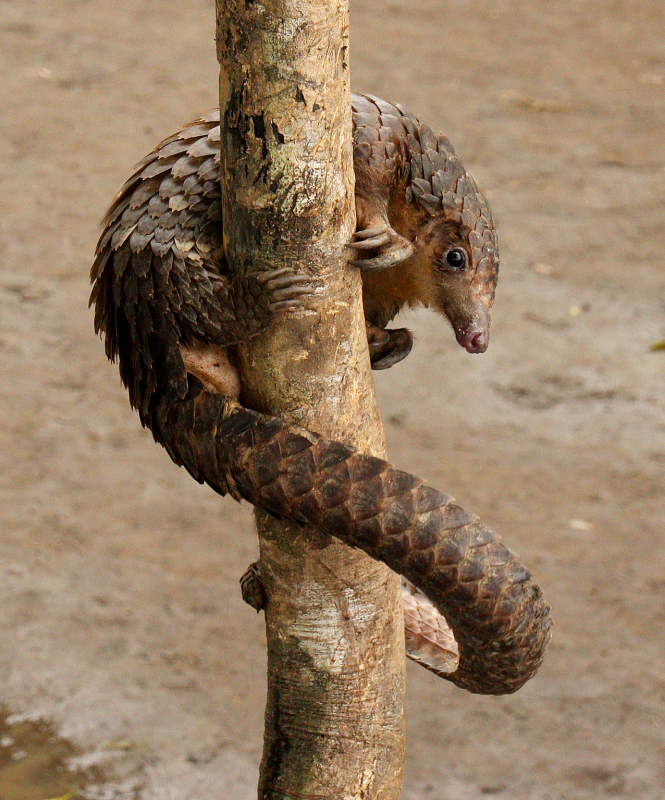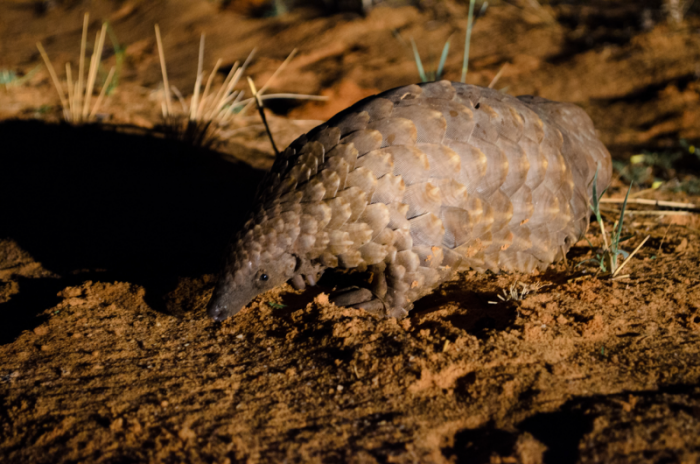Many of you might be aware that pangolins are, at present, the most illegally-trafficked mammals in the world, mainly because of the illusory medicinal value of their scales. But rather than talk about the plight of these precious creatures I want to share some of my pangolin drawings and fascinating pangolin facts with you, to show you how unique, wonderful and worth-fighting-for pangolins are.
Today, there are eight species of pangolin: four occur in Asia, in the genus Manis; four in Africa, the two small tree pangolins in the genus Phataginus, and the two larger ground pangolins in the genus Smutsia. These species range in size from 30 to 100 cm in length. My illustrations in this blog are all of the African Ground Pangolin, Smutsia temminckii, the only species to occur in South Africa.

Pangolins are instantly recognizable by their scaly skin. They have large, protective keratin (the same substance as in human fingernails) scales covering their bodies; they are the only known mammals with this feature. You could, in effect, think of a pangolin as having fingernails growing all over its body! These scales are very hard and tough, and protect pangolins in the wild even against lions and tigers.
The pangolin’s main defense mechanism is to curl up into a tight ball when threatened. The name pangolin comes from the Malay word pengguling, meaning “one who rolls up”. A mother will enfold her baby into her protective ball of scales as she rolls up. In addition to the hardness of the scales, their sharp edges also offer defense. The scales are sharp, providing extra defense from predators.

Pangolins are insectivores, eating mainly ants and termites, which they find using their keen sense of smell. Their heads have thick, swollen skin around their eye and ear openings, protecting them against bites while they feed. They have incredibly long tongues that are coated in sticky saliva. Pangolins have to generate large quantities of saliva every day, and therefor most species need easy access to water. The African Ground Pangolin is unique in being able to exist in fairly dry regions though; most other species are restricted to moist rain forests. The pangolin’s sticky tongue has an attachment that goes down beyond the throat, all the way back to the rear of the abdominal cavity! It is supported by a prong-like structure that is formed from highly modified cartilaginous ribs, located in the thorax between the sternum and the trachea. Large pangolins can extend their tongues by as much as 40 cm.
Because of their diet of ants and termites, sucked up on their sticky tongues, pangolins don’t need big mouths or strong jaws. Their lower jaw is reduced to slender bone struts and they don’t have any teeth. Instead, they have a gizzard, like those of birds, in which the ingested insects collect. This gizzard has an inner surface covered in keratinous (yes, just like the scales) spines, to grind up the insects, aided by sand and soil that the pangolins ingest along with their prey. Pangolins have very large and tough claws on their forefeet, to rip and tear into ant and termite nests.
Pangolin tails are special. Tree-dwelling pangolins have tails that are prehensile, that is, they are muscular and able to grasp onto things, helping them to climb up and down trees. There is a sensitive, naked, finger-like pad at the tip of their tails. The African long-tailed pangolin has 47 tail vertebrae, more than any other mammal! The larger ground pangolins have blunt, heavy tails; the giant pangolin can defend itself by wielding its tail like a club. The smaller ground pangolin uses its tail as a counterweight while walking. It is unique in that it can walk on its hind legs, tucking its forelegs close to its chest. This manner of walking, with the front of the body balanced by the long tail stretched out to the rear, is likely how the extinct bipedal dinosaurs walked, but today it is only the pangolin that walks like this. Lastly, a mother pangolin often carries her baby clinging to the upper surface of her tail.

So numerous and extreme are the adaptations of pangolins that it has been difficult to work out where to place them taxonomically. In days of yore they were thought to be related to the edentates (Order Edentata), mammals having few or no teeth, including the sloths, armadillos, and New World anteaters. But pangolins are only very distantly related to these species. At present, it seems their closest relatives are the members of the Order Carnivora, which include the cats, dogs, bears, skunks, raccoons, otters, badgers, weasels, mongooses, genets and civets, as well as the marine carnivores, the walruses, sea-lions and seals. Pangolins have a fossil history going back about 50 million years, some beautifully-preserved ancestors are known from sites such as the Messel Pit in Germany. One of these, Eurotamandua, was indeed first thought to be an ancient tamandua (a South American anteater), but is now considered a very old pangolin relative. Pangolin fossils show that in the past they were more widespread, having occurred in Europe and not just in Africa and Asia. Some fossil species were even larger than the present-day giant pangolin.
Ecologically, pangolins are important predators of ants and termites. In the rain forests of Africa and Asia, pangolins are the chief predators of ants and termites, keeping their population numbers in check. This means that pangolins are likely to be ‘keystone species’ in tropical rain forests; without them the ecological integrity of these habitats could be at risk. In the savannas, the ground pangolin plays a similar role, but is aided here by Aardvark Orycteropus afer and Aardwolf Proteles cristata.

A few final fascinating pangolin facts:
- They mark their territories with anal secretions and urine, some lifting up one hind leg like a dog would do;
- They mate side-to-side, sometimes intertwining their tails;
- Some pangolins like to wallow in mud, or even dung;
- Some squirt a noxious fluid like that of skunks from their backsides to deter predators or anything that threatens them.
- Though mostly silent, pangolins can growl and hiss.
The word needs to get out about pangolins. The living animals are immensely valuable and special creatures. Nobody needs the pangolin’s scales except the pangolin, let’s protect them and keep it that way!

